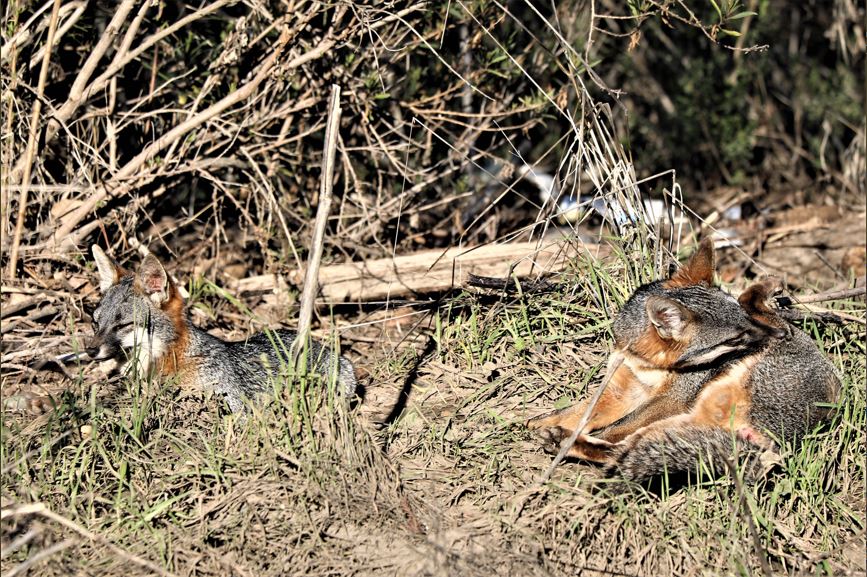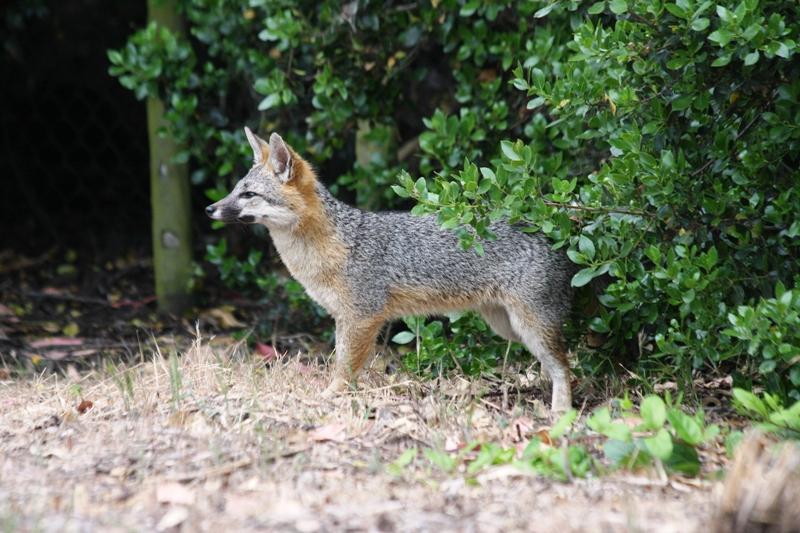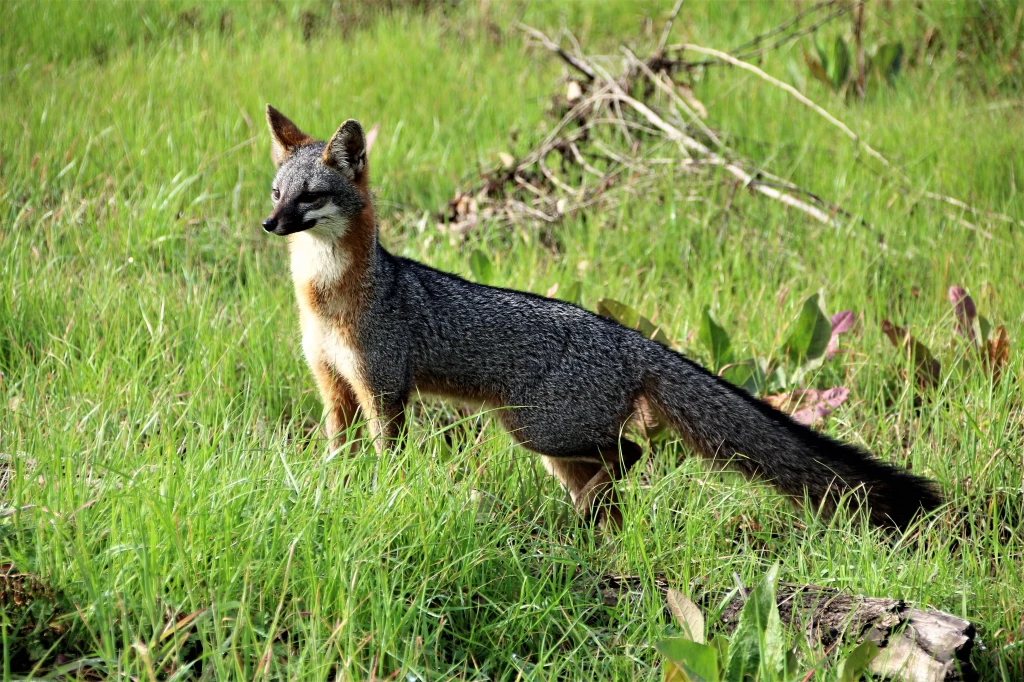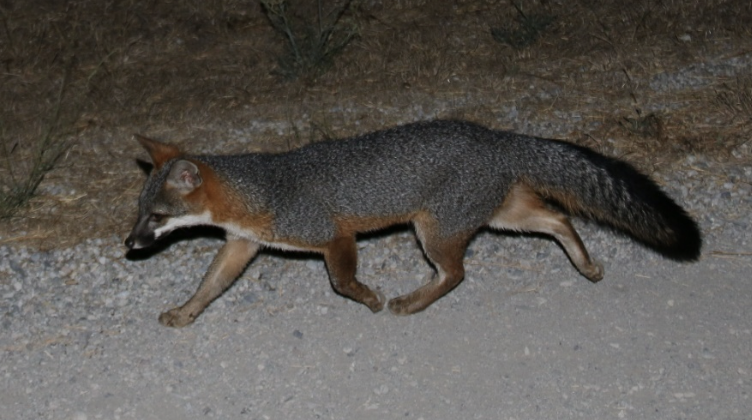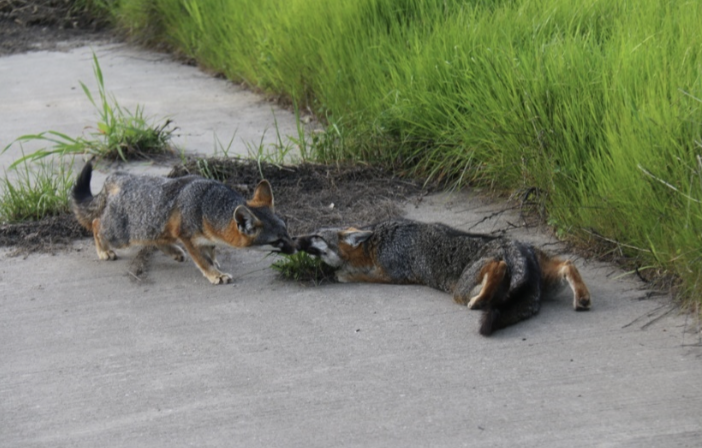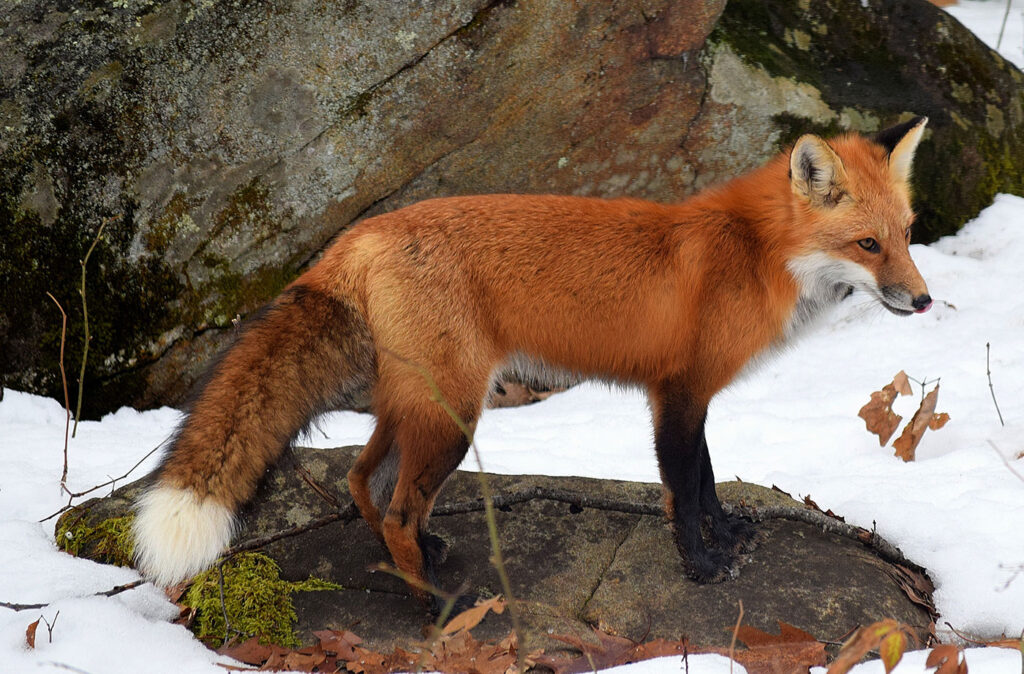Gray Fox’s Hunting Territory?
by William C. Leikam
President, CEO & Co-founder, Urban Wildlife Research Project
Floods & Wildlife on Matadero Creek
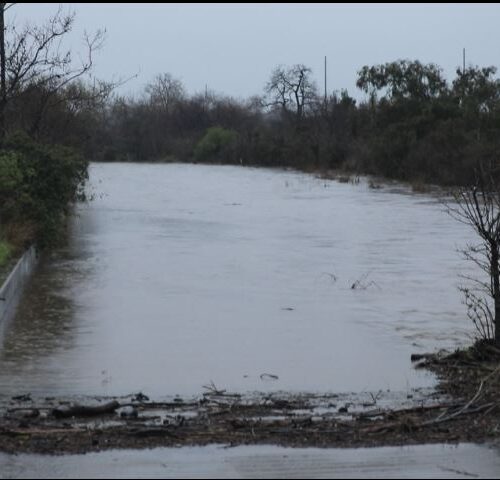 We here in Silicon Valley have just lived through one of the major rainstorm events to occur since 2017. When one inch of rain falls in the hills west of the valley and across the valley floor, then Matadero Creek and all other creeks nearby like Adobe Creek to the east and San Francisquito Creek to the north west hit high water and two of those creeks, Matadero and Adobe, will go over its banks and flow up against the two levees, on the south side of the creek and on the north side leaving very little room for the wildlife to escape the raging water. With conditions like that, I often wonder how the wildlife cope with such a sudden influx of high water. Where do the gray foxes Laimos and Big Eyes go to catch their food and to stay warm and dry in a shelter somewhere? Where do the beavers go when their lodge is flooded?
We here in Silicon Valley have just lived through one of the major rainstorm events to occur since 2017. When one inch of rain falls in the hills west of the valley and across the valley floor, then Matadero Creek and all other creeks nearby like Adobe Creek to the east and San Francisquito Creek to the north west hit high water and two of those creeks, Matadero and Adobe, will go over its banks and flow up against the two levees, on the south side of the creek and on the north side leaving very little room for the wildlife to escape the raging water. With conditions like that, I often wonder how the wildlife cope with such a sudden influx of high water. Where do the gray foxes Laimos and Big Eyes go to catch their food and to stay warm and dry in a shelter somewhere? Where do the beavers go when their lodge is flooded?
With these recent rains and high water, I saw how raccoons and other critters dealt with the water. In many cases the raccoons continued to forage at the water’s edge but now the high water, is up maybe some six feet above normal. I picked up images of these raccoons on my trail camera. One of those cameras looks directly down into the flood water and there below the trail camera swam a raccoon. They are very adept swimmers. Had someone told me that woodrats were also adept swimmers before I saw it happen, I would have likely argued that they don’t swim and that they needed to take refuge in a tree nearby, but Nature showed me that that’s not the case.

Knowing where the gray foxes Laimos and Big Eyes were denned up, I worried that they would be trapped there on Cute’s Hill which is the only high spot along that section of Matadero Creek. All the remaining land was under water. However, and to my great surprise, on one of the trail cameras over by the water treatment plant at the point of the highest water this season so far, the pair of gray foxes hunted. Somehow, they had found a way to get to their secondary hunting grounds and there they were able to sustain themselves. Once I’d seen that, I assumed that they had moved their den from Matadero Creek and were keeping their distance from the high water. That was not to be the case, for on another night and in heavy rain, those two foxes showed up along Pond Road. (This is a levee road connecting East Bayshore Road with the overflow channel along Matadero Creek.) This happened not once, but several times.
I was baffled. How could they travel from a flooded region over about a quarter mile away and return along Pond Road? The following is sheer speculation: As the creek water came higher inundating the land along the creek’s banks, they crossed a fallen tree that spanned the creek and then they trotted along the Adobe Loop Trail. They followed the road to the water treatment plant region. In order to get back to Pond Road, they’d have to cross the Matadero Creek Bridge, trot along the Adobe Loop Trail paralleling East Bayshore Road to Pond Road where they had a secondary den that was not flooded.For those who make it through, it sometimes takes a week for everything to return to normal and for the critters to return to their routines. Meanwhile, after such flooding, once the water recedes, a dozen or so turkey vultures came for a banquet and to clean up the inevitable casualties of the storm.
Section II
Update for the Urban Wildlife Research Project
On March 21st, 2023, Bill the Fox Guy Leikam will be speaking at Stanford’s Jasper Ridge Biological Preserve.
The newest documentary featuring Bill & Dr. Katherina Weikl in Zurich Switzerland is coming soon.
We’ve made a new discovery and documented the first beavers to occupy Matadero Creek in 160 years. Palo Alto Weekly https://www.paloaltoonline.com/print/story/2022/11/04/the-beaver-is-back and the San Jose Mercury News https://www.mercurynews.com/2022/11/27/the-re-beavering-of-the-bay-area/ and the Santa Cruz Sentinel https://www.santacruzsentinel.com/2022/11/28/the-re-beavering-of-the-bay-area/
This story was syndicated nationally.
A video documentary titled The Foxes, My Professors, about my work with the foxes and produced at Stanford University can be watched here.
Bill’s new book The Road to Fox Hollow has been released and can be found at Barnes & Noble Booksellers and directly from the publisher Di Angelo Publications at https://www.diangelopublications.com/books/the-road-to-fox-hollow. This is your best deal.
Dr. Marc Bekoff has an interview with Bill and that can be accessed at The Social and Emotional Lives of Urban Gray Foxes .
Bay Nature Magazine – “How to be a Fox” The article about Bill and his ethological approach to his study of the gray fox is online here: https://baynature.org/article/how-to-be-a-fox/ Many are calling this a major article in the wildlife press.
BE SURE TO check out our YouTube Channel for some incredible wildlife videos at https://www.youtube.com/channel/UC5ujc7p8dU1-O5AbPAWz2_Q and our Facebook page.
See Discipline Raccoon Style here: https://www.youtube.com/watch?v=rdZbMGlkzEk
Undoubtedly the best Radio interview ever – KALW (PBS program Crosscurrents) – by Sofie Kodner during December 2020 – Broadcast 1/11/2021 5:00 PM. Check it out here https://www.kalw.org/post/bay-area-wildlife-habitats-are-disappearing-fox-guy-has-plan
Section III
Gray Fox, Baylands Goals
Within the permit that allows the Urban Wildlife Research Project to conduct its study of the behavior of the gray fox at the Palo Alto Baylands Nature Preserve, the objectives covered area:
- Monitoring of urban gray fox Denning sites in Palo Alto Baylands.
This is being accomplished during the period when the gray foxes use a den site. It is one of the prime locations for gathering most of the behavioral data of the litter and for adults alike.
- Assessment of status and population trends of Baylands urban gray foxes
Since January 2019 a pair of resident gray foxes have claimed territory at the Palo Alto Baylands Nature Preserve.
- Identification of habitat features that promote the presence of urban gray foxes
After considering this and talking with people who know how to restore habitats, we need to assess what kinds of plants, including the Alkaline Salt Bush, would grow best along the edge of the saltwater channel and alongside the marsh. We need to grow a permanent habitat that contains the corridors and plant it as soon as possible. We’ll keep an eye on this as this is a critical link between the southern region of the Baylands and the northern region.
- Assessment of reproductive success and identification of factors that promote successful reproduction
Open up the pinch-point along Matadero Creek by developing thickets that link one area to another, instead of the present “islands”.
- Identification and assessment of possible dispersal travel routes.
Presently there can only be guesses as to dispersal travel routes. We intend to make this important question much more concrete when we attain our collaring/take/capture permit from the Department of Fish & Wildlife.

